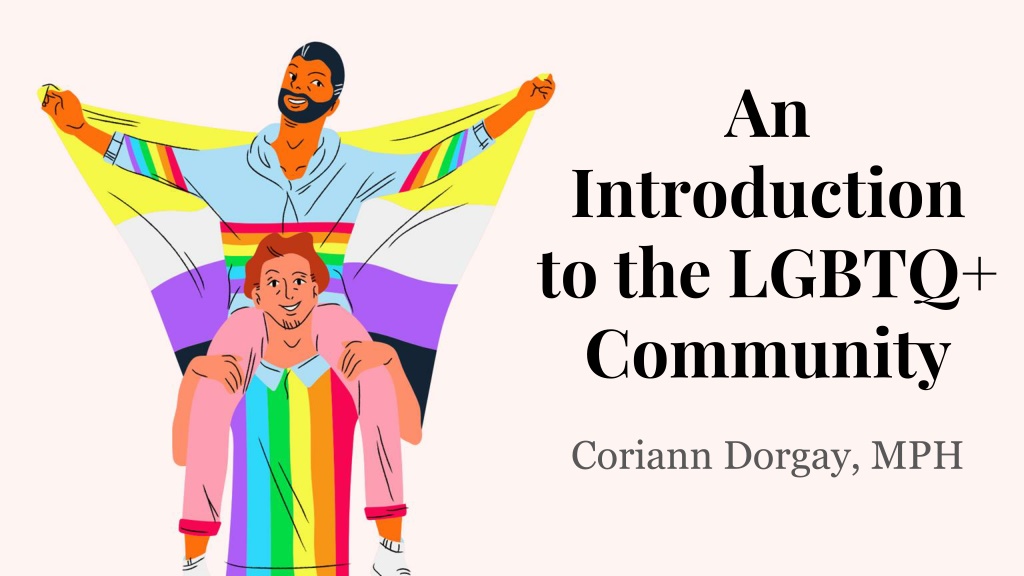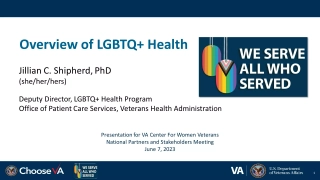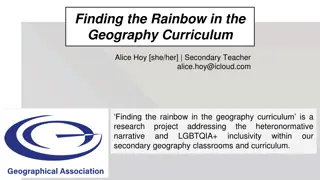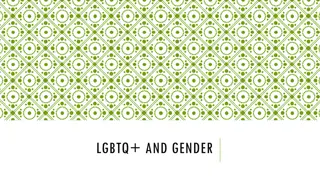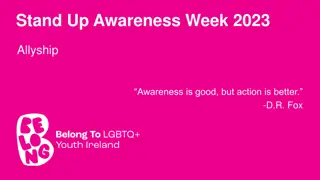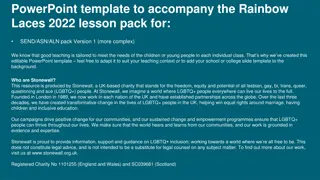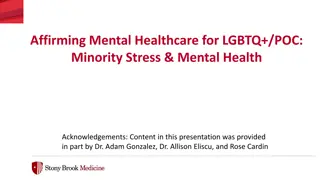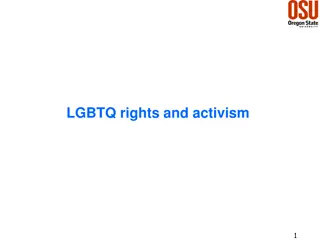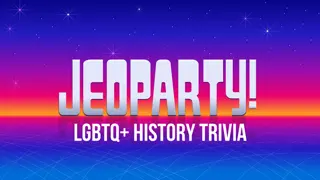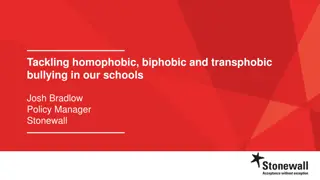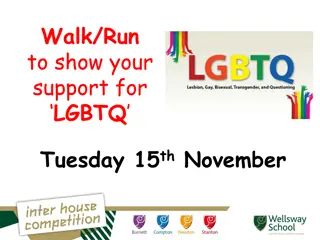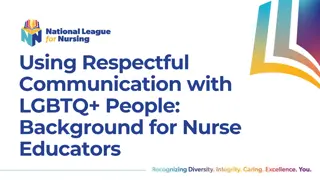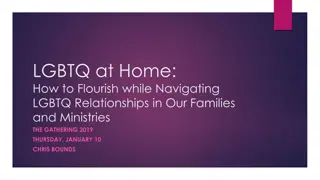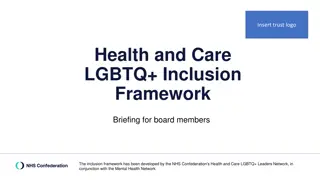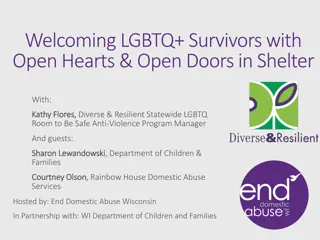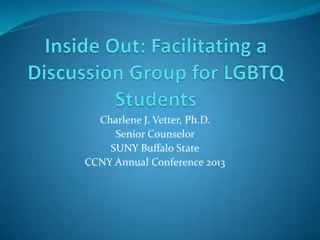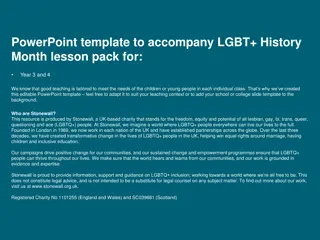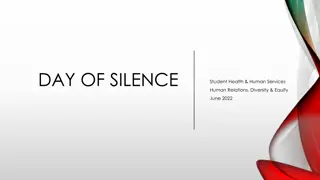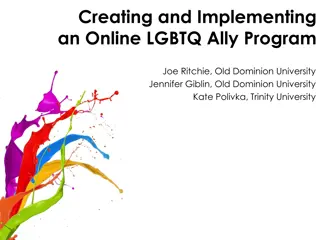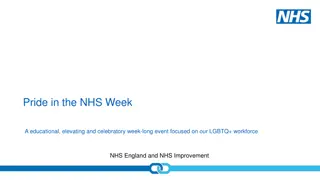The LGBTQ+ Community: A Comprehensive Overview
Exploring the history, key events, and current landscape of the LGBTQ+ community, this presentation covers significant milestones, identities, terminology, and societal shifts. Delve into the demographics, policies, and practices that impact LGBTQ+ individuals, alongside insights on being an ally.
Download Presentation

Please find below an Image/Link to download the presentation.
The content on the website is provided AS IS for your information and personal use only. It may not be sold, licensed, or shared on other websites without obtaining consent from the author.If you encounter any issues during the download, it is possible that the publisher has removed the file from their server.
You are allowed to download the files provided on this website for personal or commercial use, subject to the condition that they are used lawfully. All files are the property of their respective owners.
The content on the website is provided AS IS for your information and personal use only. It may not be sold, licensed, or shared on other websites without obtaining consent from the author.
E N D
Presentation Transcript
An Introduction to the LGBTQ+ Community Coriann Dorgay, MPH
Lesbian Gay Bisexual Trans Queer/Questioning + anyone else who doesn t identify as heterosexual or cisgender
ROADMAP FOR TODAY 1. A Little Bit About Me 2. A Brief Timeline 3. Who Makes Up the Community 4. Key Terms to Know 5. Current Policies and Practices 6. Being an Ally/What Can You Do?
A LITTLE BIT ABOUT ME Graduated in May 2021 with my Master of Public Health (MPH) from the Yale School of Public Health Wisconsin Population Health Service Fellow placed at Wood County Health Department through June 2023 She/They pronouns Identify as Queer Research interests in rural LGBTQ+ population health and harm reduction MPH Thesis - Evaluation of a pilot modified SBIRT strategy to scale-up opioid agonist therapy utilization in Moldovan prisons
1952: American Psychological Association (APA) lists homosexuality as a mental disorder 1953: President Eisenhower bans homosexuals from working for the Federal Government 1962: Illinois is the first state to decriminalize sexual acts between two consenting adult men 1965: The first gender-affirming surgery in the U.S. is conducted at Johns Hopkins Hospital 1969: Stonewall Riots in New York City 1973: APA removes homosexuality from list of mental disorders 1978: San Francisco County Supervisor Harvey Milk and Mayor George Moscone are assassinated by Dan White
1981: AIDS epidemic begins 1982: Wisconsin becomes the first state to ban discrimination on the basis of sexual orientation 1996: Defense of Marriage Act (DOMA) is passed 1998: Tammy Baldwin becomes the first openly lesbian candidate ever elected to Congress 2013: DOMA is repealed and the APA removes gender identity disorder from its list of mental disorders 2015: Marriage equality is legalized in all 50 states 2020: Federal law protects LGBTQ+ employees from negative actions taken against them by employers on the basis of their sexual orientation or gender identity
THE LGBTQ+ COMMUNITY IN THE US 4.5% of the US population (~14.8 million people) self-identified as LGBTQ+ as of 2019 10% of youth identify as LGBTQ+ 58% of the LGBTQ+ population identifies as female 29% of LGBTQ+ people are raising children 25% of the LGBTQ+ people in the US have an annual income <$24k Compared to 18% of non-LGBTQ+ people
THE LGBTQ+ COMMUNITY IN THE RURAL US Rural areas account for 97% of the US's land area Roughly 1 in 5 Americans (over 62 million people) live in rural areas Between 3% and 5% of the rural population identifies as LGBTQ+ 2.9 to 3.8 million LGBTQ+ people (15% to 20% of the total US LGBTQ+ population) live in rural areas around the country Rural youth are just as likely as urban youth to identify as LGBTQ+ Not only do LGBTQ+ people live in rural America, but many of them want to live there LGBTQ+ people in urban and rural areas report similar levels of self-defined well- being, health, and satisfaction
THE LGBTQ+ COMMUNITY IN WISCONSIN As of 2019, 3.8% of the population of Wisconsin (~221,000 people) self- identified as LGBTQ+ 59% of LGBTQ+ people are female 29% of LGBTQ+ people are raising children 25% of LGBTQ+ people have an annual income <$24k Compared to 16% of non-LGBTQ+ people
OPPRESSION Combination of prejudice and institutional power that creates a system that regularly discriminates against some groups and benefits others Members of dominant groups can limit opportunities for people that fall into marginalized groups Oppression can be experienced as limitations, disadvantages, or disapproval Oppression is a social construct that creates the closet in which LGBT+ people reside (McCann et al., 2020)
STIGMA/DISCRIMINATION Stigma can be defined as occurring when all of the following conditions are met: Human differences are distinguished and labeled; Differences are associated with negative attributes; Separating us from them (in-groups and out-groups); Out-group suffers status loss and discrimination; and Occurs in the context of unequal power between the groups Unjust actions carried out by members of a dominant group or its representatives against members of a marginalized group
TYPES OF STIGMA/DISCRIMINATION Structural Stigmatizing policies and enforcement practices Key professionals lack necessary training Economic inequality Interpersonal Healthcare discrimination Workplace discrimination Family rejection Assault Individual Concealment of stigma Avoidance of stigma Internalization of stigma White Hughto et al., 2015
INTERSECTIONALITY Describes the way that discriminatory systems interact in the lives of those with multiple marginalized identities E.g., race, gender, sexuality oppressions overlap to cause people even more hardship Life experiences are informed by these unique intersectional identities
HETERONORMATIVITY Set of attitudes and behaviors that incorrectly assumes there are only two genders (male and female) Includes the assumption that everyone is naturally heterosexual Heterosexual is the ideal and superior to homosexuality or multisexuality Assumes that people should conform to the conventional expectations of society for gender identity and gender expression
COMING OUT Process people go through as they work to accept their sexual orientation and/or gender identity and share that identity openly with others No right or wrong way to come out Not a one time thing Many people assume everyone they meet is straight Has benefits and risks
OUTING When someone s sexual orientation and/or gender identity is disclosed without their permission Forced to reveal deeply personal information without their consent and on someone else s terms Can have serious repercussions on personal safety, employment, economic stability, family situation, etc.
PASSING Being perceived as cisgender and/or heterosexual Can limit barriers and/or discrimination people face Especially trans people Not inherently good or bad Can be incredibly affirming Can be a stressful, negative source of pressure
SPECTRUM A range or sliding scale Aspects of your identity like sexual orientation, gender identity, and gender expression exist on a spectrum The linear spectrum theories we re most familiar with have been challenged in recent years Don t make room for those whose identities exist either partially or fully outside of the points that define the ends of the spectrum
PRONOUNS Linguistic tools used to refer to someone in the third person Why do pronouns matter? Many people use pronouns other than those associated with the sex they were assigned at birth Using the wrong pronouns is a form of misgendering Using the correct pronouns is a form of respect Don t ask someone for their preferred pronouns instead ask What are your pronouns? If you make a mistake, correct yourself and try to do better in the future Try saying I m sorry for misgendering you, [name]. I ll try to do better in the future. Or say Oh! I remember your pronouns are [correct pronouns], sorry about that.
PRONOUNS There are a number of ways you can show people that you are conscious of the importance of pronoun usage and that you will respect others if they choose to share theirs: Include your pronouns in your email signature and other places where your name is visible (e.g., business cards, social media profiles, etc.) Always introduce yourself with your pronouns Replace gendered language like ladies and gentlemen or guys when referring to groups of individuals with gender-inclusive language such as everyone, y all, or folks Pronouns gender It is not appropriate to only ask someone for their pronouns when you suspect that they may be transgender, nonbinary, or gender nonconforming
GENDER EXPRESSION How a person expresses themself, in terms of dress and/or behaviors Society characterizes these expressions as masculine, feminine, and androgynous Gender Non-conforming A descriptor for people who do not subscribe to societal expectations of typical gender expressions or roles More commonly used to refer to how a person behaves, acts, and presents themselves to others as opposed to someone s internal sense of self
GENDER IDENTITY A sense of one s self which may or may not correspond with the sex and gender assigned at birth Gender Dysphoria: distress experienced by people whose gender identity does not match that of their gender assigned at birth Misgender: to refer to a person in a way that does not correctly indicate their gender identity
GENDER IDENTITY Cisgender: gender identity that society deems to match the person s sex assigned at birth Trans: umbrella term to describe those whose gender identity differs from that assigned at birth More inclusive towards gender non-conforming and nonbinary people than transgender Nonbinary: a gender identity that is not solely man or woman Agender: someone who identifies as having no gender Bigender: having two genders; having characteristics of masculine and feminine gender roles Genderqueer: expansive term for gender identities that are not described by the categories male or female Genderfluid: a person whose gender identity and expression shifts
GENDER IDENTITY Two Spirit: an umbrella term encompassing sexuality and gender in Indigenous Native American communities Wanted a term that would reconnect gender or sexual identity with Native identity and culture, particularly the spiritual aspect of their traditions Two Spirit people often serve integral and important roles in their communities, such as as leaders and healers A translation of an Ojibwe term, so there is no equivalent term or meaning in other nations and tribes Does not replace the historical and traditional terms already in use or available in those tribes
TRANSITION Process of taking steps to live as one s true gender identity Form of gender affirmation Process by which a person makes social, legal, or medical changes to recognize and express their gender identity Transitioning is different for each individual and may or may not involve medical interventions like taking hormones or having surgery Two main forms of transitioning are social and medical The extent of someone s transition does not make that person s gender identity any less or more valid
QUESTIONING Used to describe someone in the process of exploration about their sexual orientation, gender identity, and/or gender expression Have a feeling they might be different but still discovering what that means for them Allows people to identify as part of the LGBTQ+ community while avoiding labels and honoring the process of exploration
QUEER Historically used as a derogatory slur Reclaimed by some members of the LGBTQ+ community to describe a non-heterosexual and/or non-cisgender identity Should not be used to describe individuals or groups unless their preference is known
SEXUAL ORIENTATION An enduring sexual attraction or non-attraction to other people Can be fluid Not a conscious choice that can be changed Distinct from an individual s gender identity People can use many different labels to describe their sexual orientation
SEXUAL ORIENTATION Asexual: rarely or never feel sexual attraction Multisexual: umbrella term to describe sexual attraction to more than one gender Bisexual: sexual attraction to people of the same and different genders Pansexual: sexual attraction to people regardless of their gender Polysexual: sexual attraction to people of more than one gender, but not all, genders Monosexual: umbrella term to describe sexual attraction to only one gender Heterosexual: sexual attraction to the opposite gender Lesbian: a woman who feels sexually attracted to other women Gay: sexual attraction to the same gender; typically refers to men attracted to other men Demisexual: only experience sexual attraction with people they have formed an emotional bond with
ROMANTIC ORIENTATION Attraction to other people characterized by the expression or non- expression of love Individuals who experience sexual attraction often have alignment between their sexual and romantic orientations They experience sexual attraction towards the same gender(s) they are interested in forming romantic relationships with People can use a variety of labels to describe their romantic orientation
ROMANTIC ORIENTATION Aromantic: do not feel romantic attraction or have any desire for a romantic relationship Biromantic: romantic attraction to both the same and different genders Demiromantic: do not experience romantic attraction until they have formed an emotional bond with someone Heteroromantic: romantic attraction towards people of a different gender Homoromantic: romantic attraction towards people of the same gender Panromantic: romantic attraction towards people regardless of their gender Polyromantic: romantic attraction towards multiple, but not all, genders
INTERSEX Umbrella term used to describe a wide range of body variations that don t fit into conventional definitions of male or female May include variations in chromosome compositions, hormone concentrations, and external/internal characteristics 1.7% of babies are born with some form of intersex anatomy 1 in 2,000 of these infants are recommended for early cosmetic genital surgery by doctors There is no research that shows that early surgery is helpful instead evidence shows that it can cause numerous physical problems
Movement Advancement Project Equality Maps Snapshot: LGBTQ Equality By State
Movement Advancement Project Equality Maps: Housing Nondiscrimination Laws
HOUSING & HEALTH Having adequate, stable, and safe housing is foundational to a person s well-being Homeless and unstably housed LGBTQ youth report higher rates of Substance use Poor mental health Physical and sexual violence Risky sexual activity Turning to survival sex Non-sexual subsistence strategies
HOUSING INSTABILITY IN THE LGBTQ+ COMMUNITY 17% of sexual minority adults report experiencing homeless at some point in their lifetime 6% in the general population LGBT people experienced prior-year homelessness or housing instability at a rate over double that of the general population 20% and 9.7%, respectively Studies estimate that LGBTQ youth make up between 20% and 45% of homeless youth Family rejection
DISCRIMINATION IN HOUSING Approximately 3 complaints of sexual orientation and gender identity discrimination in housing are filed for every 100,000 LGBT adults each year Rental providers were less likely to schedule an appointment with gay men, told them about fewer available units, and quoted them $272 more in average yearly rental costs (Levy et al., 2017) Male and female same-sex couples were less likely to receive favorable responses to their inquiries than different-sex couples (Friedman et al., 2013) 6% of US Trans Survey respondents reported being denied a home or apartment due to their gender identity in the previous year 5% reported being evicted
DISCRIMINATION IN SHELTERS Report harassment, violence, and other challenges in shelters and when accessing other services LGBTQ youth consistently report being bullied, harassed, and even assaulted by other youth Staff is either unresponsive or punishes the LGBTQ youth by isolating them 70% of trans people who experienced homelessness and stayed in a shelter in the previous year reported some form of mistreatment
ALLY Someone who actively supports equal rights, equality, and LGBTQ+ social movements even though they are not a member of the community themselves A true ally Has words and actions that are in sync Lifts others up by advocating for them Recognizes and understands the adversity faced by the LGBTQ+ community Listens, supports, and reflects Makes room for LGBTQ+ people to exist Does more than just show up for Pride Doesn t view discussions of their privilege as a personal attack
ACTIONS YOU CAN TAKE AS AN INDIVIDUAL Stay informed Speak up Support equality Come out as an ally
ANTI-STIGMA INTERVENTIONS Structural-level Produced by social reform Changing laws or policies Modifying physical environments Providing training to key professionals (e.g., healthcare providers, educators, etc.) Need to be complemented with individual-level interventions Individual-level Educational interventions Provide information to refute common stereotypes associated with the stigmatized identity Contact-based interventions Based on Allport s Intergroup Contact Hypothesis Prejudice may be reduced by equal status contact between majority and minority groups; in pursuit of common goals; sanctioned by institutional support (laws and customs) Adapted from slides by Katie Wang, PhD
STRUCTURAL-LEVEL HOUSING INTERVENTIONS Comprehensive federal and state protections against sexual orientation and gender identity discrimination Federal and state agencies should enforce existing/create new rules that prohibit discrimination in programs and services that receive federal or state funding Expand housing and shelter options for LGBT youth and adults Sheltered safely and appropriately Increase number of affirming agencies
STAFF TRAINING Mandate training for all staff at agencies providing housing, child welfare, homelessness, and other services to the LGBTQ+ population Ensure that staff become and remain equipped to serve LGBTQ+ people Beyond cultural competency to LGBTQ+ preparedness Part of a coordinated plan grounded in policy Not one and done
DONT BE AFRAID TO MAKE MISTAKES It s okay to make good faith mistakes along the way Ask questions, clarify, and apologize if necessary Continue making the effort to be a person and inhabit a space where LGBTQ+ people can feel comfortable and supported
THANK YOU
